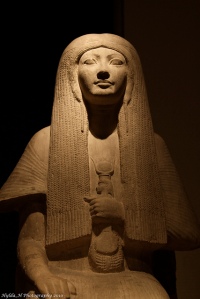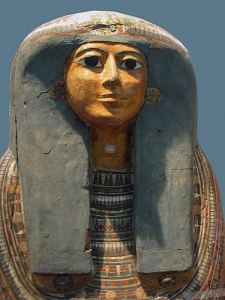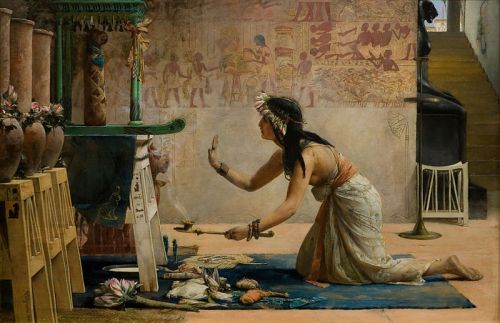Our topic today? Sexism in egyptology.
Well, it’s actually priestesses in ancient Egypt, but it was a bunch of sexist assumptions by previous generations of egyptologists that allowed the importance of priestesses to be overlooked or discounted and inspired me to choose this topic for the post.
What sort of sexist assumptions you say?
Many old-school egyptologists have assumed that women were not allowed to participate in the most holy—that is, most important—aspects of worship. They have assumed that the sacerdotal titles of high-status Egyptian women were simply honorary and the women did not actually perform the work of a priestess. Such assumptions are never made when it comes to Egyptian men with corresponding titles. Never. By translating the Egyptian term, Servant of the God—which was used of both men and women—as priest or priestess, the old gentlemen were allowing themselves a little mental sexism for, in their minds, a priestess was always of lower status than a priest because in their society women were of lower status than men. It was assumed that the religious involvement of women with priestly titles was not “professional” and when Egyptian religion became “more organized” in the New Kingdom, there was an effort to exclude women.
Sheldon Gosline, the author of a scholarly article I’m reading on this topic, believes this assumption is mainly based on Christian and Jewish exclusion of women from priestly activities rather than on any real evidence from Egypt. There has also been the assumption—less these days than it was, thank Goddess—that women’s roles in the temple were mainly sexual; that the female musicians were some sort of harem (because music is inherently sexual, you see) and that the God’s Wife, another priestessly title, was supposed to have sex with the priests of the temple who represented the God. Such assumptions were, no doubt, based on statements like this one from the Greek geographer Strabo, himself hailing from a supremely sexist culture. Says Strabo:
“To Zeus [Amun] they consecrate one of the most beautiful girls of the most illustrious family . . . She becomes a prostitute and has intercourse with whoever she wishes, until the purification of her body [menstruation] takes place.”
(We are always hearing tales of temple prostitution, are we not? It’s just so…so…well, pagan.) In fact, there is no evidence of Egyptian temple prostitution or that priestesses were expected to have sex—sacred or otherwise—in the temple. In fact, the opposite is true; one was decidedly NOT supposed to have sex in the temple. (None of this is to say that sex had no place in ancient Egyptian religion and culture; it did, and an important place. But that’s a topic for another day. And that other day has come. Here’s the article about that.)
Thankfully, more modern egyptologists are taking a less biased view.
So what’s the real story?
Unfortunately, due to the incomplete nature of the evidence, we can never be entirely certain. Yet we do have the opportunity to look at what evidence remains in a fresh way. When we do so, we notice that we have records of quite a large number of ancient Egyptian priestesses. These records come from all periods and regions of Egypt. We see that supposedly honorific titles were borne by some women who were not married to priests or who were married to men of lower rank. In other words, the woman’s status was her own and she did not derive it from her husband. From the fifth dynasty we have a record that shows that the sons and daughter of one noble family took turns being the Servant of the God of Hathor. The religious duties of the sister Servant of the God would have been the same as those of the brother Servant of the God or it would not have been possible to switch off like that. We also have records showing that lower-ranked priestesses and priests were paid exactly the same amount for their temple service, which must indicate the equal importance and likely equal duties the job entailed. We have evidence that the priestessly title of Meret, “Beloved,” may have been quite a high-ranking position. At least one Meret priestess was responsible for the financial security of the temple through care for its real estate and agricultural resources—a very important role and one that must have required a great deal of education and experience.
As Egypt came in contact with other cultures or due to internal Egyptian politics, it seems that some priestessly power eroded. Perhaps this is why Hatshepsut’s grandmother felt the need to revive the important title of God’s Wife, which Hatshepsut later took for herself. From the New Kingdom on, we find many priestesses with the title of Chantress and may be tempted to dismiss it as a minor role, yet it may well be that we are undervaluing the vital role that music played in the worship of the Goddesses and Gods. Many of the women with this title were royal and noble. We have letters surviving from some of these Chantresses that indicate they wielded a great deal of power. The Great Chantress of Amun wrote to a military official sharply ordering him to supply rations for the workmen: “Don’t let [name of another official] complain to me again,” she writes. “Have them prepared for the people…” Women tended to prefer using their title of Chantress even over other prestigious titles they may have held, which surely indicates the title’s high status.
Like other Deities, Isis would have been served by Her priestesses. They would have made music and sung hymns for Her, presided over offerings, and perhaps even tended Her temple’s real estate holdings. In fact, by the New Kingdom, Isis was one of the Deities (others are Amun, Montu, Mut, and Osiris) most commonly served by priestesses.
A lovely 19th century painting by John Weguelin of a priestess making offerings for the ka of a cat








